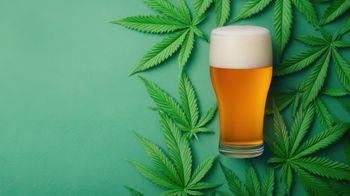
Are Fermented-Produced Cannabinoids Similar to Plant-Produced Compounds?
In this interview, Maria Enquist-Newman, PhD, Director of R&D Program Management at Demetrix, delves into the specifics of fermentation-produced cannabinoids and how this method can benefit the cannabis industry.
New innovations in technology are constantly changing the cannabis landscape. For example, Demetrix, a biotechnology company, has engineered yeast to make specific molecules that are used in a fermentation process to produce cannabinoids. Here, Maria Enquist-Newman, PhD, Director of R&D Program Management at Demetrix, delves into the specifics of fermentation-produced cannabinoids and how this method can benefit the cannabis industry.
Can you tell us about Demetrix and some of the work you do there? Why use fermentation to produce cannabinoids (1)?
Maria Enquist-Newman: Demetrix is a biotechnology company that believes in the power of science to make the world a better place. The company produces safe, legal, and effective health and wellness products backed by science, including rare, high-purity cannabinoids for pharmaceutical and consumer applications.
Demetrix has a team of industry-leading experts across Research & Development (R&D), production, regulation, and commercialization, with deep experience bringing fermentation products to market. The company is pioneering the study of the more than 100 rare cannabinoids and their interactions with the human body.
We use regular baker’s yeast to produce natural molecules that natively are made by the cannabis plant. By engineering our yeast to make specific molecules, we can get access to very rare cannabinoids in an affordable and sustainable way.
How do you use baker’s yeast and fermentation to produce cannabinoids?
Enquist-Newman: Our team has rich experience bringing fermentation products to market, across R&D, manufacturing, and commercialization. We use biotechnology to engineer the DNA in baker’s yeast to produce rare cannabinoids. This method is more sustainable, socially responsible, scalable, and consistent than obtaining these ingredients from agriculture. More than 1000 yeast cells would fit on a single trichome on the cannabis plant, which gives a sense of the sheer scale at which cannabinoids can be produced via fermentation. Also, while our cannabinoids are the same as those found in the plant, it is important to note that we don’t use any part of the plant to produce our cannabinoids.
How did you get started working with cannabinoids?
Enquist-Newman: I joined Demetrix in 2019, and that was when I stared working with cannabinoids. I was very excited to join the Demetrix team as I strongly believe in this approach to produce cannabinoids—it is a sustainable and affordable method. It is a rapidly evolving field, and I was very impressed with Demetrix’s groundbreaking fermentation technology.
Due to the stigma on cannabis, do you feel that this limits the potential to find out more about the medicinal properties of the plant? Are there fewer research opportunities?
Enquist-Newman: The fact that no one has even been able to do research on this interesting family of molecules until recently definitely means that the field has been held back. What we are doing is providing the needed access to these compounds so that proper research can be performed to uncover their potential to improve health and wellness.
How does your company plan to expand cannabinoid research and what is your role in that?
Enquist-Newman: Our work is focused on making rare cannabinoids available at commercial levels at affordable prices and in a sustainable way. The first molecule we are bringing to commercial scale is cannabigerol (CBG). We are going to continue to expand our portfolio of rare cannabinoids and our foundational research to learn more about how each one can safely, legally, and effectively promote human health and wellness.
Can you tell us a little about the research you uncovered in the recent article title “A pathogenesis-related 10 protein catalyzes the final step in thebaine biosynthesis” (2)?
Enquist-Newman: This work that I was part of at my previous company also involved introducing plant genes into yeast with the goal of producing molecules via fermentation. Thebaine is a precursor in the morphine pathway and we were aiming to produce thebaine via fermentation in a more sustainable and controlled fashion than its normal production method from opium poppy. As we introduced the long and complex thebaine pathway into yeast, it became clear that there was a missing step in the pathway: the last step that converts (7S)-salutaridinol 7-O-acetate to thebaine has for long been presumed to be spontaneous. However, as we were looking closer into this, through a nice collaboration with an academic laboratory, we discovered a novel enzyme that catalyzes this step, subsequently named “thebaine synthase.”
Can you tell us about some the work related to the article “Efficient ethanol production from brown macroalgae sugars by a synthetic yeast platform” (3)? Did you use any of those methods to produce synthetic cannabinoids?
Enquist-Newman: This work was part of my first job at a synthetic biology company. Also at this company, as we do at Demetrix, we used yeast to make a natural process more efficient and sustainable. In this case, we engineered yeast to be able to utilize kelp (brown macroalgae) to make ethanol. Kelp can be farmed, and since it grows in the ocean, there is no “food versus fuel” dilemma. There is no need for watering, and not even a need for fertilizers. Kelp does, however, contain some unusual carbohydrates that native yeast can’t utilize. We therefore had to introduce some non-native genes into yeast that allowed it to break down kelp. Yeast would then utilize these building blocks and turn them into ethanol (native product of yeast).
Since this was addressing the “feedstock” (alternative ways for yeast to take up carbon), this could in theory be paired up with any downstream pathway engineering, including making cannabinoids.
As for the strain engineering tools and engineering, though the field has evolved in the last few years, we are definitely using a lot of the same standard techniques to modify our yeast today as we did in that work.
Also, it is important to understand that synthetic cannabinoids are chemically produced and very different to cannabinoids produced by yeast or by the plant. The cannabinoids we currently product at Demetrix are natural and have the exact same molecular structure as those found in the plant.
Have you used other microbes to produce cannabinoids?
Enquist-Newman: We are currently focusing our work on yeast and scaling our fermentations to commercial production.
Is there anything you would like to see change in the cannabis industry, in regard to research, legislation, etc.?
Enquist-Newman: The cannabis industry is comprised of two distinct markets—recreational and health and wellness. The latter centers on the non-psychoactive cannabinoids where federal legalization has been achieved. The recreational market has a strong tetrahydrocannabinol (THC) product focus.
We do not make psychoactive cannabinoids and are therefore focused on the health and wellness markets. Currently, we see a lot of positive movement with research and legislation in health and wellness and believe that this class of compounds holds a lot of promise to improve lives around the world.
What are your future plans in the cannabis industry?
Enquist-Newman: We are completely focused on providing access to the rare non-psychoactive cannabinoids. We are aiming to expand our research of rare cannabinoids, adding our insight to a diverse portfolio of knowledge about these rare ingredients.
References
Newsletter
Unlock the latest breakthroughs in cannabis science—subscribe now to get expert insights, research, and industry updates delivered to your inbox.





